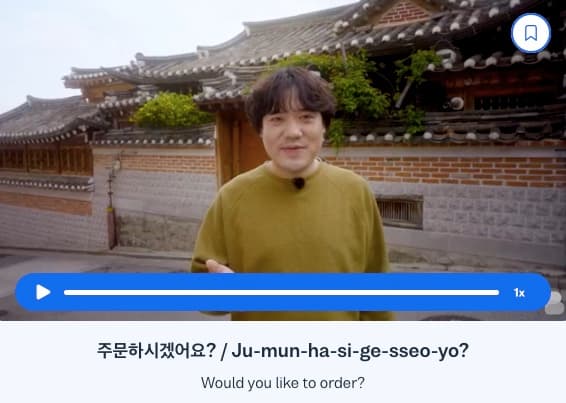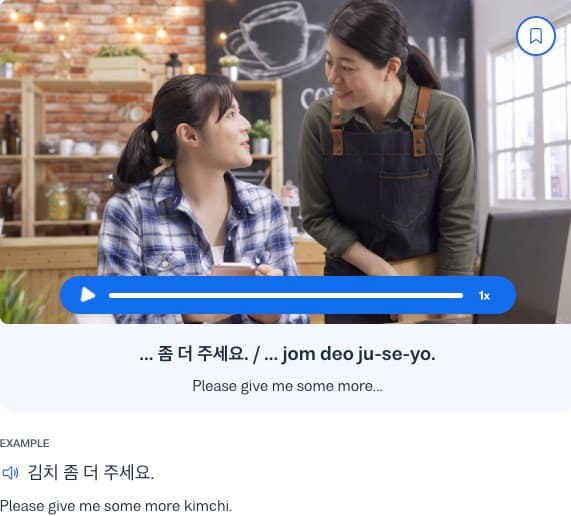How to Order Food in Korean
Make your Korean dining experience extra special by learning to order food in Korean!
Author:

Keehwan Kim
When people plan trips to Korea, trying different kinds of food is very high on the list of things to do. Korean barbecue, 비빔밥 (bibimbap), 떡볶이 (tteokbokki) - the list goes on and on.
However, in order to try different kinds of food in Korea, you need to be able to order food in Korean. Learning how to order food in Korean will help you to order food not only in restaurants in large cities like Seoul, but from street vendors and restaurants in other smaller cities like Busan and Jeju.
This comprehensive article explores all the key expressions you need to order food in Korea, and by the end of reading this article, you will have the confidence to walk into any restaurant in Korea.
Ordering food in Korean: Summary list of useful phrases
어서 오세요! (Eo-seo o-se-yo!) - Welcome (Please come in)
몇 분이세요? (Myeot bun i-se-yo?) - How many people are there?
주문하시겠어요? (Ju-mun-ha-si-ge-sseo-yo?) - Would you like to order?
뭐 드릴까요? (Mwo deu-ril-kka-yo?) - What can I get for you?
비빔밥 일 인분 주세요. (Bi-bim-bap il in-bun ju-se-yo.) - Please give me 1 portion of bibimbap.
김치찌개 이 인분 주세요. (Kim-chi-jji-gae i in-bun ju-se-yo.) - Please give me 2 portions of Kimchi stew.
삼겹살 삼 인분 주세요. (Sam-gyep-sal sam in-bun ju-se-yo.) - Please give me 3 portions of pork belly.
음료는 어떻게 하시겠어요? (Eum-nyo-neun eo-tteo-ke ha-si-ge-sseo-yo?) - What would you like for drinks?
물 한 병 주세요. (Mum han byeong ju-se-yo.) - One bottle of water, please.
맥주 두 병 주세요. (Maek-ju du byeong ju-se-yo.) - Two bottles of beer, please.
저기요, 반찬 좀 더 주세요. (Jeo-gi-yo, ban-chan jom deo ju-se-yo.) - Excuse me, please give me some more side dishes.
저기요, 김치 좀 더 주세요. (Jeo-gi-yo, kim-chi jom deo ju-se-yo.) - Excuse me, please give me some more kimchi.
뭐가 맛있어요? (Mwo-ga ma-si-sseo-yo?) - What’s delicious? (What would you recommend?)
포장 돼요? (Po-jang dwe-yo?) - Can I take it to go?
잘 먹었습니다. (Jal meo-geo-sseum-ni-da.) - Thank you for the meal.
Korean phrases when entering a restaurant
Upon entering a restaurant, a server may bow to greet the customer and say 어서 오세요. 어서 오세요 literally means ‘please come’, and it’s often used in restaurants and stores to welcome customers.
For example:
어서 오세요! (Eo-seo o-se-yo!) - Welcome (Please come in)
To ask how many people there are in your party, the server in the restaurant can ask 몇 분이세요. 몇 분 means ‘how many people’. 몇 means ‘how many’ and 분 is a word we use to count people.
“How many people?” in Korean
| Korean | English |
|---|---|
| 몇 분이세요? (Myeot bun i-se-yo?) | How many people are there? |
| 두 명이요. (Du myeong-i-yo.) | Two people. |
However, 분 is the honorific form, so when we respond and tell the server how many people there are in our group, we use 명 and say 두 명 (two people). 명 is a standard word we use to count people, so while the server can use 분 to be respectful to the customer, when we answer, we should use 분. Lastly, to say how many people there are, we need to use native Korean number with 명.
“Two people, please!” in Korean
| Korean | English |
|---|---|
| 두 명이요. (Du myeong-i-yo.) | Two people. |
| 세 명이요. (Se myeong-i-yo.) | Three people. |
Ordering food in Korean
Korean dining experience is a little different from Western dining experience. In most restaurants, there are no starters or desserts. You just have the main meal, and in general, the server will take your order for the food and then the drinks. So let’s begin with what the server might ask to take your order.
“Would you like to order?” in Korean
| Korean | English |
|---|---|
| 주문하시겠어요? (Ju-mun-ha-si-ge-sseo-yo?) | Would you like to order? |
| 뭐 드릴까요? (Mwo deu-ril-kka-yo?) | What can I get for you? |
주문하다 means ‘to order’ and we add 시겠어요 (would like to) to the verb and make 주문하시겠어요? (Would you like to order?)
드릴까요 means ‘should I give you’, and if we add 뭐 in front and make 뭐 드릴까요, it means ‘What should I give you?’ or ‘What can I get for you?’
To answer the server’s question and order food, we can say something like this.
“One bibimbap, please!” in Korean
| Korean | English |
|---|---|
| 비빔밥 일 인분 주세요 (Bi-bim-bap il in-bun ju-se-yo.) | Please give me 1 portion of bibimbap. |
| 김치찌개 이 인분 주세요. (Kim-chi-jji-gae i in-bun ju-se-yo.) | Please give me 2 portions of Kimchi stew. |
| 삼겹살 삼 인분 주세요. (Sam-gyep-sal sam in-bun ju-se-yo.) | Please give me 3 portions of pork belly. |
The key phrase is ‘_인분 주세요’. 인분 means ‘portion’, and 주세요 means ‘please give’, so together, 인분 주세요 kind of means ‘please give meportions’. In front of 인분 주세요, we can say the food we want, and a number word to say how many portions, or dishes we want. So if we want to order one bibimbap, we can say비빔밥 일인분 주세요.
One important point to note is that we use Sino-Korean numbers with 인분 to say how many portions or dishes we want. So one portion is NOT 한 인분, but 일 인분, and two portions is NOT 두 인분, but 이 인분.
Ordering drinks in Korean
After we’ve ordered our drinks, the server may ask to find out what drinks we want, and to do this, they can ask the following questions:
“What would you like for drinks?” in Korean
| Korean | English |
|---|---|
| 음료는 어떻게 하시겠어요? (Eum-nyo-neun eo-tteo-ke ha-si-ge-sseo-yo?) | What would you like for drinks? |
| 술은 어떻게 하시겠어요? (Su-reun eo-tteo-ke ha-si-ge-sseo-yo?) | What would you like for alcohol? |
The key phrase is ‘____ 은/는 어떻게 하시겠어요?’ And this phrase means ‘What would you like to do’. In front of this question phrase, we can use words related to drinks. 음료 means ‘drink, beverage’ and we use 음료 to refer to soft drinks like fizzy drinks and juices. 술 means ‘alcoholic drink’, and it’s quite common for servers to ask what alcoholic drink someone would like.
When we say 음료 and 술, we use the topic particles 은 and 는. 음료 ends in the vowel ㅛ, so we use it with 는 and say 음료는. 술 ends in a final consonant ㄹ, so we use it with 은 and say 술은.
To order drinks, we can say something like this:
“One bottle of water, please.” in Korean
| Korean | English |
|---|---|
| 물 한 병 주세요. (Mul han byeong ju-se-yo.) | One bottle of water, please. |
| 맥주 두 병 주세요. | Two bottles of beer, please. |
The key phrase is ‘병 주세요’. 병 means ‘bottle’ and 주세요 means ‘please give’, so this phrase means ‘Please give mebottle.’ In front of this phrase, we can say the drink we want and a native Korean number to say how many bottles we want. So to ask for one bottle of water, we would say 물 한 병 주세요.
Making food requests in Korean
Korean dining experience is all about the side dishes, 반찬 (ban-chan). Every meal comes with an assortment of side dishes, the most common one being 김치 (kimchi), and in Korea side dishes are free, so you can always ask for more side dishes. To ask for more side dishes, you can say something like this:
“Excuse me, please give me more side dishes.” in Korean
| Korean | English |
|---|---|
| 저기요, 반찬 좀 더 주세요. (Jeo-gi-yo, ban-chan jom deo ju-se-yo.) | Excuse me, please give me more side dishes. |
| 저기요, 김치 좀 더 주세요. (Jeo-gi-yo, kim-chi jom deo ju-se-yo.) | Excuse me, please give me more kimchi. |
First, 저기요 is a form of ‘excuse me’, and we say 저기요 to catch someone’s attention. In Korea, to catch the server’s attention, it’s totally fine to raise your voice a little and shout ‘저기요!’ (Make sure not to shout out too loud!).
And after that, the key phrase is ‘____ 좀 더 주세요.’ 좀 means ‘some’ and 더 means ‘more’ and 주세요 means ‘please give’, so in front of this key phrase, we can add the side dish we want. So to ask for more kimchi, we can say 김치 좀 더 주세요.
Another common request is when we ask for grills to be changed at Korean barbecue restaurants.
For example:
저기요, 판 갈아 주세요. (Jeo-gi-yo, pan ga-ra ju-se-yo.) - Excuse me, please change the grill.
판 means grill, and 갈아 주세요 means ‘please change’. 갈아 주세요 combines 갈다 (to change) with 주세요 which we can use to ask someone to do something. So altogether 저기요, 판 갈아 주세요 means ‘Excuse me, please change the grill’.
Korean phrases when leaving the restaurant
Once you’ve enjoyed your meal, it’s time to pay and leave. First, we can ask for the bill like this:
For example:
저기요, 계산서 주세요. (Jeo-gi-yo, gye-san-seo ju-se-yo.) - Excuse me, please give me the bill.
Here, the word 계산서 means the bill, so 계산서 주세요 means, ‘please give me the bill’.
One important point to note is that in many Korean restaurants, Koreans don’t ask for the bill. Instead, they just walk up to the paying counter, which is usually by the exit, and pay for their meals. So if you see a paying counter by the door, feel free to pay for your meal as you leave the restaurant.
To ask whether you can pay by card, cash, or maybe Apple Pay, you can ask questions like these:
“Can I pay by card?” in Korean
| Korean | English |
|---|---|
| 카드로 내도 돼요? (Ka-deu-ro nae-do dwe-yo?) | Can I pay by card? |
| 현금으로 내도 돼요? (Hyeon-geum-eu-ro nae-do dwe-yo?) | Can I pay by card? |
| 애플페이로 내도 돼요? (Ae-peul-pe-i-ro nae-do dwe-yo?) | Can I pay by Apple Pay? |
The key phrase is ‘____로/으로 내도 돼요?’ 내도 돼요? means ‘Can one pay?’, and 로/으로 is similar in meaning to ‘by’, and in the blank, we can add 카드 (card), 현금 (cash), or 애플페이 (Apple Pay) to ask whether we can use these payment methods.
Whether we use 로 or 으로 depends on the noun. 카드 and 애플페이 end in the vowels ㅡ and ㅣ, so we use 로 and say 카드로 and 애플페이로. However, 현금 ends in the final consonant ㅁ, so we use 으로 and say 현금으로.
Useful phrases in Korean restaurants
Here are a few other useful expressions you can use at Korean restaurants:
For example:
고기 빼 주세요. (Go-gi ppae ju-se-yo.)- Please take out the meat.
The key phrase is ‘_빼 주세요’, and this means ‘please take out’. So whatever your food preference is, you can use this phrase to ask for certain ingredients to be taken out of a dish.
“Is this spicy?” in Korean
| Korean | English |
|---|---|
| 이거 매워요? (I-geo mae-wo-yo?) | Is this spicy? |
| 덜 맵게 해 주세요. (Deol maep-ge hae ju-se-yo.) | Please make it less spicy. |
One of the key ingredients in Korean foods is 고추가루, ground spicy pepper, and this means that nearly all Korean foods are somewhat spicy - some more than others. So if you’re not into spicy food, you can ask whether something is spicy, and you can ask the second question to ask for something to be made less spicy.
For example:
뭐가 맛있어요? (Mwo-ga ma-si-sseo-yo?) - What’s delicious? (What would you recommend?)
To ask for recommendations from the server, we use this question 뭐가 맛있어요?, which literally means ‘What’s delicious?’
For example:
포장 돼요? (Po-jang dwe-yo?) - Can I take it to go?
포장 means wrapping, and 돼요? means ‘Is it possible?’, so this question means ‘Is wrapping possible?’ You can use this question to ask street vendors whether you can take food to go, or at the end of a meal at a restaurant when you want to take home the rest of the food you have ordered.
For example:
잘 먹었습니다. (Jal meo-geo-sseum-ni-da.) - Thank you for the meal.
At the end of the meal, we say 잘 먹었습니다 to express our gratitude for the meal, and we can say this at home to our parents who have prepared our food, but also to servers in restaurants who have served our food. So after finishing your meal, you can say 잘 먹었습니다 to be polite.
For example:
수고하세요. (Su-go-ha-se-yo.) - Thank you for your hard work.
When we leave restaurants, we can say the standard form of goodbye, 안녕히 계세요. However, another common form of goodbye is 수고하세요. 수고하세요 literally means ‘please continue to work hard’, but we often say this as a form of goodbye to workers in shops and restaurants, and we use this phrase to show our appreciation for their hard work.
Ordering food in Korean: Recap
Going to Korean restaurants can be quite daunting, especially as the dining experience itself can be quite different. However, the phrases in this article will help you navigate your way through your dining experience in Korean restaurants. Oh and one last thing, Koreans don’t tip in restaurants - and that’s one less thing to worry about!
AUTHOR

Keehwan Kim
Newlanguages


